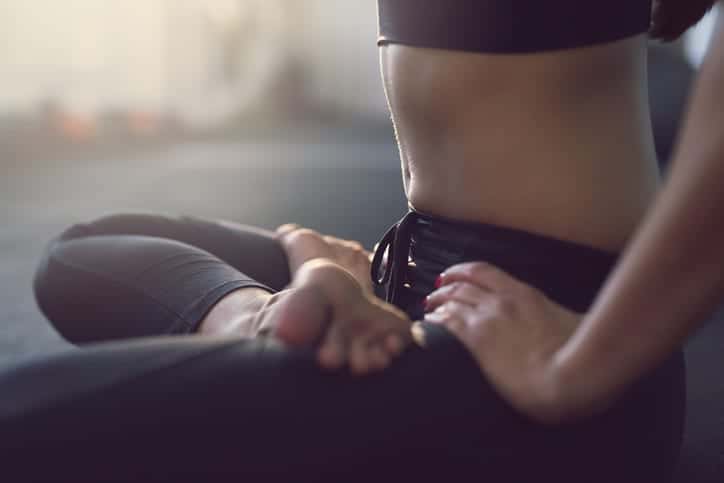The world has become a much more anxious place.
Unfortunately, The Black Dog Institutes has noted, “Common consequences of disease outbreaks include anxiety and panic…with estimates of between 25% to 33% of the community experiencing high levels of worry and anxiety during…pandemics” similar to the one we are facing today.
Many people may also be experiencing an anxiety disorder for the first time and may not know how or what can help.
Dr Greg Smith has worked with hundreds of people suffering anxiety conditions over the years and knows just how important breathing, mental and physiological techniques are for the very anxious.
This is something Greg has refined over 35 years as a psychologist, yoga teacher and educator.
He has developed powerful techniques for using breathing as a tool to help rapidly reduce states you don’t want (such as stress, anxiety, agitation, depression) and increase states you do want (feeling calmer, stronger, more energized or inspired).
In the following extract from Greg’s new book, Purposeful Breathing, discover skills that blend Eastern traditions and Western science to give you access to the life-changing power of breathing and mental health exercises to help drop your anxiety levels by up to 30 per cent.
Breathing to overcome anxiety and panic
Having worked with hundreds of people suffering anxiety conditions over the years, I can say that there are common breathing changes that happen to almost everyone when they are very anxious.
Breathing becomes sharper and high in the chest, and either the person then holds the breath, or their breathing rate escalates.
These are distinct patterns without any depth of exhalation, and both keep the person stuck in the fight or flight anxiety state.
I think this happens for almost everyone when they become anxious and it is certainly true for me. I notice if I feel stressed and anxious, I often have a high breath and shallow exhalation.
To manage anxiety, it really helps to focus on the exhalation. If you can take a slow, deep, extended exhalation, you quickly begin to lower the anxiety level.
‘Quickly’ is a tricky word here, because when people are anxious, they want to act quickly, to do rapid things to fix their anxiety and remove the threat.
The rapid calm of breathing comes from breathing slowly and exhaling fully.
It is rapid because in one or two breaths you can drop your anxiety level by 20 or 30 per cent.
I say 20 or 30 per cent because in working with people suffering anxiety I often ask them to rate their anxiety on a scale of 1 to 10, where 1 is totally relaxed, like being at the beach on a warm summer’s day, and 10 is totally overwhelmed by anxiety.
It takes a few minutes to teach the technique but typically people will go from 7 to 5; 6 to 4; or occasionally 8 to 4. The amount of reduction averages about 30 per cent on the scale.
Occasionally it takes someone a while to learn the breath, but once they are used to it, I find almost everyone can drop their anxiety rate by 2 points on the scale within a few breaths.
The key is to breathe diaphragmatically and slowly. If you are in an anxious state it is often easiest to learn belly breathing first.
Belly breathing techniques
‘Belly breathing’ is often the quickest and easiest way for many people to use their diaphragm. It produces a sense of being calm and centred.
- Sit with a straight back and with your feet on the floor, and place one hand on your chest and one hand over the navel.
- As you breathe, notice which hand moves more: with your inhalation or exhalation?
- Many people typically chest breathe, so that during an inhalation the hand on the chest moves outward more than the other hand.
For belly breathing the simple guideline is: breathing in, the belly goes out; breathing out, the belly goes in.
Using abdominal muscles

To get the feeling of this, it helps to actively use the muscles of your abdomen on the exhalation, squeezing in the belly to squeeze the air out.
It can also help to gently push in on the belly with the hand when breathing out — this focuses attention there and helps you get used to the movement.
The main movement should be felt in the belly rather than the chest.
How belly breathing works
Belly breathing is relatively easily learnt, even when people are highly anxious, and has a calming effect.
Once you are more practised at belly breathing the focus will move to the diaphragm.
The belly should gently and passively move out on the inhalation as the diaphragm contracts and pulls down.
The emphasis in belly breathing is on the exhalation, which can be extended by drawing in the abdominal muscles.
Help with sleep
Belly breathing is great for relaxing at night, and I have taught it to many people who have difficulty with sleep.
Lying down on your back put one hand on your belly; breathing in, your hand goes gently up, and breathing out it goes gently down.
Breathing like this can help sleep because it has a physically relaxing effect (by switching on the rest and relax response) and because it gives the mind a gentle focus — many people have trouble sleeping because their minds are racing or churning over worries, so this helps to shift out of the talking and thinking mode into gentle body-awareness sensing mode.
Breathing to stop panic attacks
What is a panic attack?
Panic attacks can be terrifying — they are an extreme, powerful surge of anxiety.
Typically in a panic attack, the person feels extreme anxiety and hyperventilates, breathing very fast and shallow.
Often people fear that they are going to die, fearing heart attacks or complete collapse.

Using breath to stop panic attacks
Using the breath is a powerful way to control and stop panic attacks. As a first step, it helps to recognize a panic attack for what it is.
After you have one it is good to get a medical check to make sure that, for example, fear of having a heart attack is not because you are at risk of a heart attack.
Once medical issues are ruled out, you can learn to recognize a panic attack when it happens and to know that it will pass.
This acts to stop a common vicious cycle in which the initial anxiety kicks off a feeling of being anxious about being anxious, and panicking about the panic, so that everything worsens.
Recognizing it means you can know it is unpleasant, but not ultimately harmful, and this helps it to pass more quickly.
One of the frightening things about panic attacks is that the hyperventilation produces very strong effects.
Because you are breathing so fast, you breathe out way too much carbon dioxide, which results in less oxygen to the brain.
This can lead to dizziness, trouble thinking clearly and a host of other symptoms.
In the middle of a panic attack slow, deep breathing will have a profound and positive effect, but generally you have to have a well-established breathing practice to be able to do it in the middle of a panic attack because the tendency to be caught in hyperventilation is very strong.
Key things to know
It takes some muscular effort to control the breathing at a time like this.
I can testify it works, but it is much better if you can try to recognize the build-up to the panic attack.
Then using slow, deep diaphragmatic breathing will be calming and prevent escalation. Once you do practice enough, however, you can control it even with an attack.
One client, Penny, who had a history of panic attacks, found that she could develop control over her breathing, and found that it worked best for her to breathe in for a count of four then breathe out for a count of eight.
She could stop the attacks within a minute.
Another option is to pause after the exhalation. This brings the carbon dioxide balance back up.
This isn’t always easy to do if you are panicking but it brings your system back into balance.
Just keep breathing

It may sound a bit dumb to say it, but often the most important thing to do is just keep breathing…The more you focus on breathing, the more you can become aware of it as a simple source of joy.
Even a single breath, when given our full attention, is a powerful reminder that we are alive, and what a remarkable thing that is. It directs attention to the drawing in of life energy.
It allows our physicality to be felt as an active thing, interlinked with emotions and ways of thinking.
Just stopping now and again and taking a few purposeful breaths feels good, grounds you in your body and, depending on the style of the breath, can be calming, centring, or energizing.
This is an edited extract from Purposeful Breathing by Dr Greg Smith, published by Exisle Publishing.
Dr Greg Smith is a psychologist who combines an interest in empowering styles of psychotherapy with a passion for yoga, meditation and mind–body awareness.







